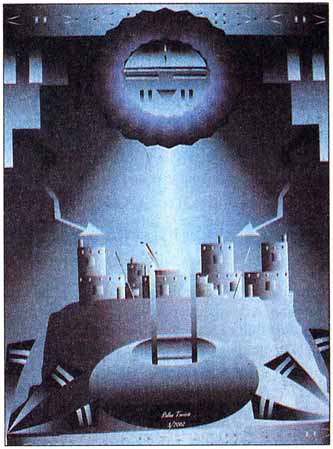The CMN team's rocket, the Golden Eagle, not only achieved its goal, it exceeded it, by soaring to an altitude of 5,000 feet. The students, faculty and staff were ecstatic in their victory "with our little wooden and cardboard rocket" they called "the little rocket that could," over high-tech contenders constructed of fiberglass and carbon-fiber.
It is not surprising that the team succeeded. Indians have an innate natural intelligence and had an intimate relationship with the stars since prehistory. Plains Indians prepared winter counts, or histories of their tribes, based on the astral calendar; petroglyphs are believed to convey celestial events; and tepees and hogans were oriented to the stars and designed both to stay cool in the summer and warm in the winter. The stars hold a prominent place in Native spirituality and provide inspiration for participation in the great order of the universe. Many cultures believe that heavenly bodies are ancestors or carry their ancestors' spirits, and Indian astronomers chronicled events in the universe.


3 comments:
Writerfella here --
The famed scientist and founder of the think-tank Hudson Institute, Herman Kahn, formulated his long-held belief that Native cultures worldwide had an implicit understanding of science and technology that required no more than just contact with new science and/or technology. His observations started with the tribes of New Guinea when a truck refused to start and a Native walked over, inspected the engine and its components, and then reached in to reattach a vacuum hose. The truck started, much to the chagrin of the owner scientists, and Herman Kahn began his philosophical appreciation at that moment. What is ignored by modern science is that the pattern designs on the Nazca Plains could only have been accomplished by beings situated high above the plateau. Remains of primitive but actual hot-air balloons have been found buried on the Nazca Plain. Is there really any mystery left unexplained, therefore? The facts are documented in many publications, but still one hears that 'aliens' were the source of those designs. How scientific or unscientific are the continuation of claims that the Natives could not possibly have accomplished the Nazca Lines? Hmmm,...
All Best
Russ Bates
'writerfella'
The Nazca balloon theory is just a theory. The Nazca Indians could've created the lines from the ground.
Writerfella here --
writerfella has the paperback book that documents the discovery of hotair balloon remains buried on the Nazca Plains. It therefore is not a theory at all, as the evidence was found. The difference between theory and reality is that proof exists and theory simply is thought without proof...
All Best
Russ Bates
'writerfella'
Post a Comment